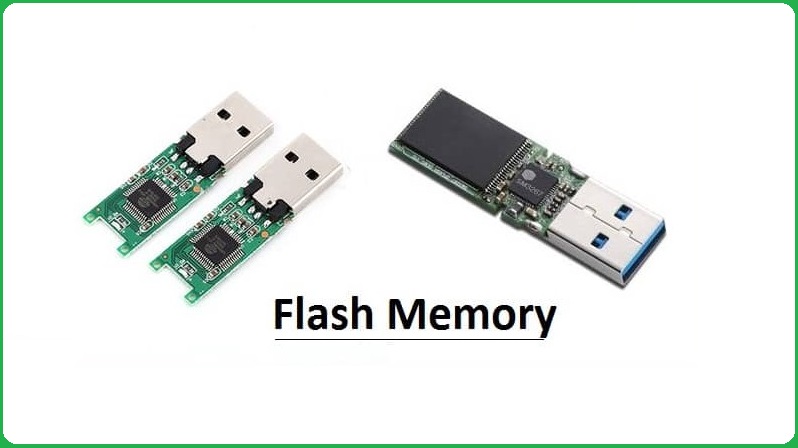What is Flash Memory?
Definition: Flash Memory was introduced by Dr. Fujio Masuoka in 1980. Flash memory has another name the electronically erasable programmable read only memory (EEPROM).
This is because; in which piece of code like as programming can be write and erased by electrically. Flash memory also uses for the storing data to computers as well as electronic devices such as USB flash drives, MP3 players, digital cameras and solid-state drives.
Flash memory is non volatile in nature because all data persisted in the memory when power is turn-off.
Types of Flash Memory
Flash Memory divided into two types based on using technology, such as:
NOR Flash Memory
NOR flash memory do executing into XIP Memory, that means all programs and instructions saved into NOR flash. And these programs execute itself with using of NOR flash without accessing any copied data into Main Memory.
NOR flash memory has higher reading speed compare to NAND flash memory. But, it has not good speed to write and delete data. It is high cost effectiveness in small capacity of 1 – 4 MB.
NAND Flash Memory
NAND flash is best option to access much such as block devices, like as Hard Disk. If, you needs to higher data storage capacity then NAND flash memory is great selection for you. It delivers tech higher densities and enlarges capacity with affordable price. It is capable to erase, sequential writes and sequential reads with higher speed.
Four types of Flash Memory as per User Requirements, such as:
Traditional Flash Storage
In the traditional flash storage, we used the HDD storage techniques. And this technique delivers the cost-effective capacity so due to that, users have flexibility to scale this system.
Also Read: Types of Computer Hardware Parts and Their Functions
Due to unreliable, several experts suggest that this storage capacity is not capable to store data more than 50%. Some Expert advises that traditional flash storage contains the best vulnerable for holding information. And they break down most often inconvenient and risky for the user.
Server Flash Memory
Server Flash Memory prefers the cache storage capacity because it allows to users access data with higher speed along with lower storage capacity. But, now it is getting more popularity because its property is adding IOPS, and it grows flash memory with using functioning parallel host application.
So due to this big advantage now mostly people’s first preferred selection is Server Flash Memory. It is getting more popularity than to other using flash memory because this memory permits to IT organization to improve speed of storage and decrease the latency with more efficiently.
The All Flash Array
All Flash Array contains the best consistent storage capacity. It works as the solid state storage because it allows to multiple flash memory drivers, instead of spinning the hard disk drives. All Flash Array is getting more popularity, and as per the IDC predicting it will be grew up $5 Billion by end of 2021.
Hybrid Array
Hybrid Array flash memory has another name the Intelligent Caching Solution. It delivers you sub millisecond access for cached data, and it leverages HHD storage capacity. Hybrid array needs the higher workload. Mostly, experts trust that could soon become a popular option.
Examples of Flash Memory
There are various examples of flash memory, below explain each one:
Storage Devices and Examples of Flash Memory:
USB Flash Drive: USB flash drive has also other names like as USB thumb drive, USB stick or Pen drive. It is light weight portable storage device that used as “”Plug and Play. Now these days, USB flash drive totally replaced with compact disc.
Also Read: Types of CPU Registers with its Functions
This is because, you can plug it into USB port of the computer system then USB flash drive is capable to store most important files, folders or data.
CF (Compact Flash): Compact Flash is also a different type of flash memory, but this memory is mostly preferred in the digital cameras for holding images. It is using also other devices like as portable music players and PDA.
Compact Flash card has two variants like as “Type I” and “Type II”. Type I card is 3.3 mm thick, but other is 5 mm thick.
M.2 SSD: M.2 SSD stands for “M.2 Solid-State Drive” that used in internally mounted storage expansion cards as per the computer industry specification.
Memory Card: It is storage medium of different types of data such as images, video or text. Memory card is mostly using into several devices such as digital camcorders, handheld computers, MP3 players, printer, digital cameras and more.
MMC: MMC stands for “Multi Media Card”, and it is small type of memory card that using as flash memory into several portable devices like as PCs, music media player, smart phones, video camcorders, car navigation, and more.
NVMe: NVMe stands for “Non-Volatile Memory Express” that used as host controller interface and storage protocol for flash and next generation SSDs. This provides the higher throughput and fastest response times for different types of enterprise workloads.
SDHC Card: SDHC stands for “Secure Digital High Capacity card”, and it is advance version of the SD card along with storage capacity up to 32 GB.
Smart Media Card: It is a data storage medium device, and it contains the flash memory that helps to hold data. SmartMedia Card introduced by the Toshiba with storage capacity from 2 MB to 128 MB, and its physical dimensions of 45mm x 37mm x .76mm.
Sony Memory Stick: Sony Memory Stick is also flash memory card. Sony Memory Stick was introduced by Sony in 1998 for digital storage in some portable devices such as digital cameras, video camcorder, and other devices.
SD Card: SD card is also known as “Secure Digital Memory Card”, and it is part of the flash memory. SD card designed by Panasonic, Toshiba and SanDisk in 1999 for data storage in the cameras and phones.
SSD: SSD stands for “Solid-State Drive”, and it is data storage medium. SSD is a non-volatile memory to store and access any types of data. It does not contain any moving parts, so it delivers the faster access time, noiseless operation, higher reliability, and lower power consumption.
xD Picture Card: Its full form is “EXtreme Digital Picture Card” that designed by FUji and Olympus, in 2002 for using in the digital cameras.
Advantages of Flash Memory
There are several benefits of flash memory, such as:
Also Read: What is Trackball with Their Function and Use?
- It saves all data when power is getting turn off.
- Higher speed of read and write than traditional memory.
- Smaller size
- Portability
- Consume less power compare to traditional memory.
- Low chances to damage
- Lesser price to traditional drives
- It does not contain any moveable parts.
- Work more quietly compare to physical hard drive
Disadvantages of Flash Memory
Here, we will spread light on few limitations of flash memory, such as:
- Flash memory contains a limited number of write and erases cycles before failing.
- Flash memory does not contain any write-protection mechanism.
- It is more costly than hard disk (Cost per MB)
- Easy to lose due to its smaller size
- Writing (1->0) is costly.
- Erasing (0->1) is more costly.
- It needs advance version of program to run on a flash based drive to secure from prematurely wearing out the drive.




